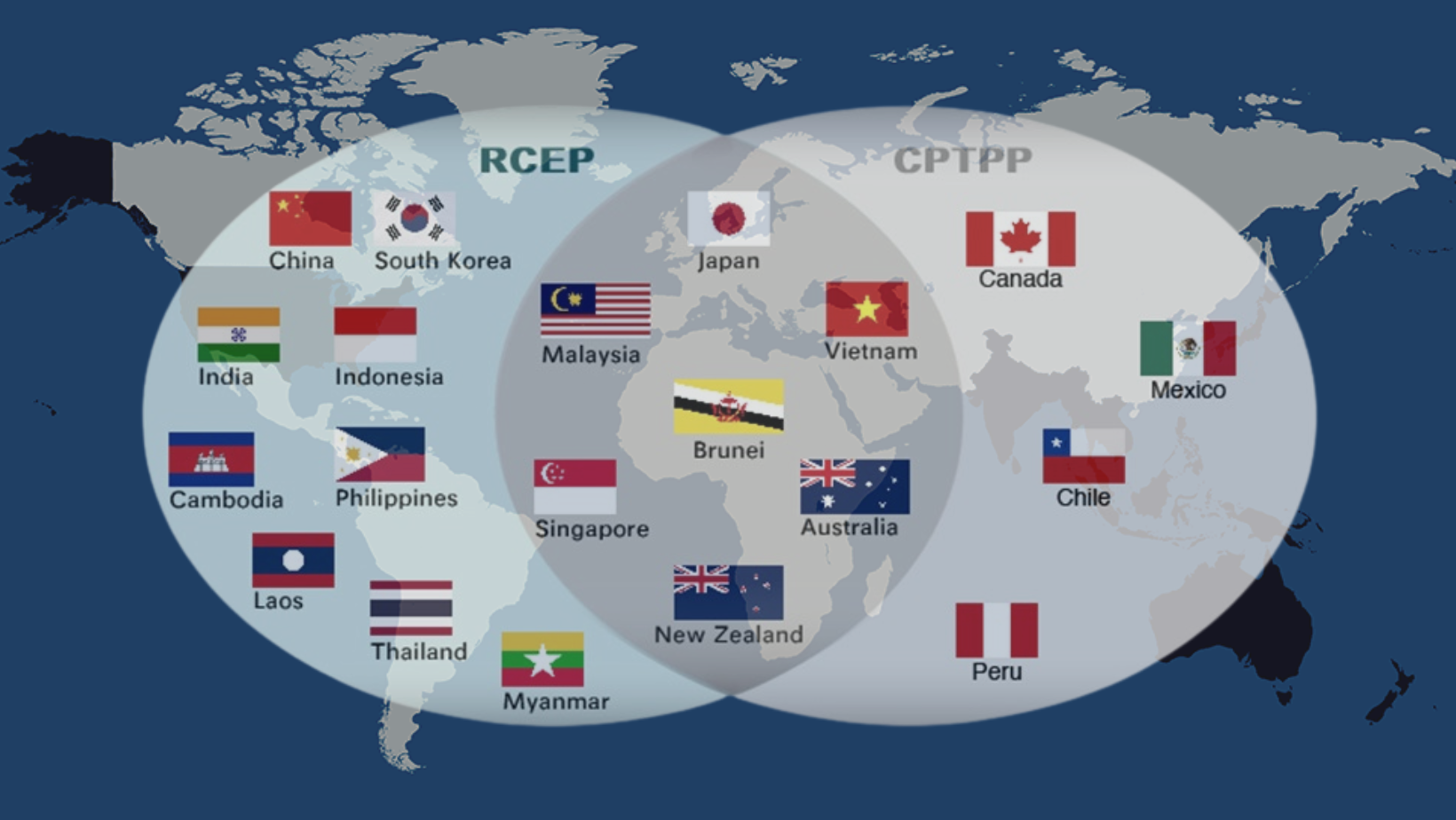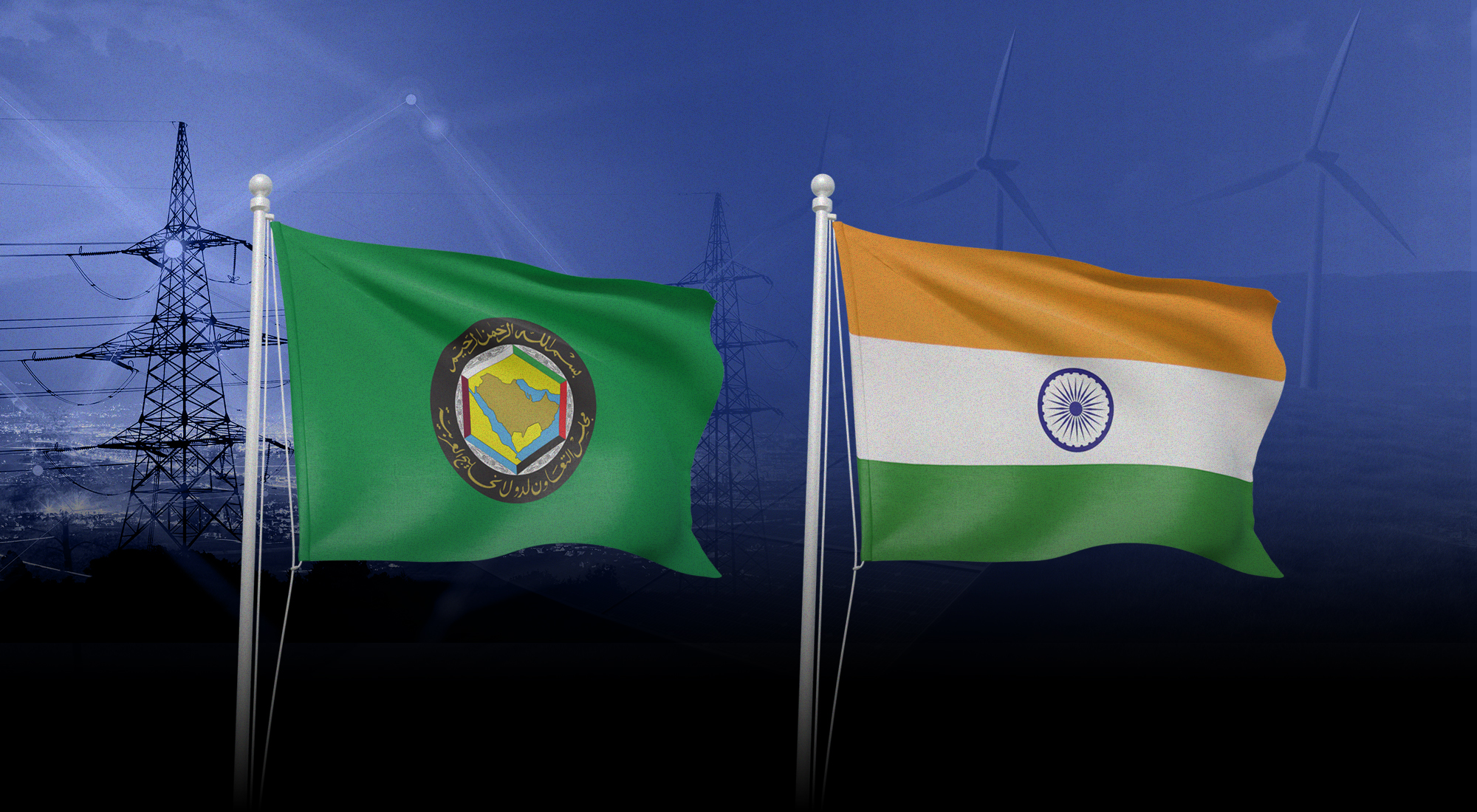The Indo-Pacific region is undergoing a trade agreement bonanza. In mid-April, South Korea announced its plan to join the Comprehensive and Progressive Agreement for Trans-Pacific Partnership (CPTPP), following almost a decade of careful deliberations. The South Korean government is expected to submit its official application for the pan-regional trade deal as soon as it clears domestic procedures, namely the submission of a report to the Korean National Assembly in accordance with the country’s Commercial Treaties Act.[1]
Last year, China, Taiwan and the United Kingdom (UK) also officially submitted their applications to join the 11-member trade pact, which is nominally led by Japan. It boasts a diverse membership that stretches from Mexico, Chile and Canada in the Americas to Australia and New Zealand in the Pacific to Vietnam, Singapore and Malaysia in Southeast Asia. The CPTPP membership accounts for 13 percent of the global Gross Domestic Product (GDP) and as much as 15 percent of global trade volume. Should South Korea, the UK, China and Taiwan be admitted, those already impressive figures could more than double.[2]
Earlier this year, fifteen nations across the Indo-Pacific launched the world’s biggest trade agreement in generations. The Regional Comprehensive Economic Partnership (RCEP) aims to further integrate the diverse economies of Australia, Brunei, Cambodia, Laos, Singapore, Thailand, Vietnam, China, New Zeeland and Japan. Covering 2.2 billion people, and boasting a combined $26.2 trillion GDP output, the RCEP accounts for 30 percent of the global population and economy.[3] Technically speaking, however, the two agreements are fundamentally different, although they both represent renewed interest in free trade across the Indo-Pacific.
On its part, the RCEP is a traditional free trade pact, which aims to reduce tariff rates by as much as 90 percent, as well as facilitate physical trade through harmonization of regulatory frameworks across members states. The CPTPP, meanwhile, is a far more ambitious and intrusive trade agreement, which targets the role of state-owned enterprises in domestic economy, enhances the power of transnational corporations over sovereign states, and dramatically liberalizes the services sector among member states. For this reason, trade pacts such as CPTPP have drawn criticism from no less than Nobel Prize economist Joseph Stiglitz.[4]
What is common between RCEP and CPTPP, however, is the glaring absence of the world’s largest economy and the putative hegemon in the Indo-Pacific: The United States. Amid a surge in trade protectionism and nationalist populism at home, former US President Donald Trump nixed his predecessor’s plan to join the earlier iteration of the CPTPP, namely the Trans-Pacific Partnership (TPP) Agreement, which was crafted by the Obama administration in order to preserve America’s geopolitical influence in the region in response to a resurgent China. The Biden administration has tried to remedy the situation by promising to develop “a comprehensive Indo-Pacific Economic Framework,”[5] as well as an interim pact, namely a Digital Free Trade deal. Meanwhile, key US partners of Australia and India have also finalized a new bilateral trade agreement in order to enhance economic interdependence among members of the Quadrilateral Security Dialogue, better known as the “Quad”.
America’s retreat
In recent years, the US has doubled down on its naval footprint across the Indo-Pacific in a clear show of force amid rising maritime tensions in the region. The Pentagon deployed 10 carrier strike groups to the hotly contested South China Sea last year, significantly higher than in 2020 (six times) and 2019 (five times).[6] Expanded naval deployment has gone hand in hand with steadily increasing joint military exercises with, as well as Foreign Military Financing (FMF) assistance to regional allies and strategic partners. In 2021, for instance, the US and the Philippines planned as many as 300 joint military activities.[7]
In fairness, the Biden administration has also stepped-up diplomatic engagement across the region, including its hosting of the first-ever summit among Quad leaders in 2021, in addition to multiple ministerial-level dialogues among top foreign and defense officials of the US, Australia, Japan and India. During its first year in office, the Biden administration also conducted multiple high-level visits to Southeast Asia, a theatre of geopolitical competition among major powers.
Within a span of weeks, the US Secretary of Defense Lloyd Austin and Vice-President Kamala Harris visited both Singapore and Vietnam, underscoring the depth of Washington’s commitment to maintaining a broad network of cooperative partnerships across the region. The problem, however, is that the US has no corresponding increase in its economic footprint in the region. No less than Singapore’s Deputy Prime Minister Heng Swee Keat has called on the US to provide an “equally substantial alternative” to the TPP, since the “the U.S. cannot afford to be absent from the region’s evolving economic architecture.”[8]
America’s economic retreat from Asia is a curious phenomenon, especially when one considers how economically dominant the country was just over half-a-century ago. In the 1960s, the US alone accounted for 40 percent of global GDP (down to 24 percent in 2019),[9] while the US share of global exports was almost 12 percent as recent as the early 1980s (down to 8 percent in 2020).[10]
Three factors, in particular, largely explain America’s declining economic power on the global level, while Asian behemoths such as China, India, and South Korea have been climbing up the ladder with unprecedented speed in the past two decades. To begin with, the introduction of aggressive neo-liberal market reforms throughout the 1980s and 1990s, which hamstrung Washington’s industrial policy and reduced state participation in strategic sectors, significantly eroded the country’s manufacturing base.[11]
The emergence of so-called ‘rustbelts’ throughout the once thriving towns across the Midwest most dramatically exemplifies the depth of the impact of market reforms during the Reaganite and Clintonite eras. And this brings us to the second factor, namely the corresponding social-political backlash against decades-long outsourcing and trade liberalization, which propelled an economic boom in places such as Mexico and China at the expense of domestic workers in America. Amid historic wage stagnation and rising inequality at home,[12] a growing number of Americans embraced trade protectionism and nationalist populism.
This was clearly demonstrated by Trump’s extremely resonant “America First” campaign during the 2016 elections, his ‘fair trade’ pronouncements once in power, and the popularity of his subsequent trade wars against China and other major exporting nations.[13] The final factor, which explains America’s relative economic weakness, is inherent to its capitalist economic structure: Unlike state-dominated economic systems such as China’s, the US cannot directly corral major businesses towards specific strategic objectives, including targeted and large-scale foreign investments.
China’s moment
America’s relative decline as an economic power on the global stage coincided with China’s unprecedented resurgence. Within a single generation, the communist nation went from one of the world’s poorest nations into the world’s second largest economy, with an upper-middle-income populace. In 1990, China’s GDP was equivalent to only 6 percent of America’s; just three decades later, China’s GDP was 60 percent of that of America’s in nominal terms – an astonishing 10-fold increase.[14]
Even more dramatic is China’s growing influence on the trading front. Globally, China has become the world’s largest trading nation, accounting for almost 15 percent of total exports in 2020.[15] In East Asia, China’s share of regional GDP increased from 8 percent in 1990 to 51 percent in 2014; the same period saw China’s share of regional trade increasing from 8 percent to 39 percent.[16] The COVID-19 pandemic, which devastated major economies in 2020, has further accentuated China’s economic power. The Asian nation was the only major economy to post growth that year, placing it in a strong position to become the world’s largest economy within the decade.[17]
China’s growing economic footprint has clear geopolitical implications. As prominent Beijing-based scholar Yan Xuetong bluntly put it: “The policy now is to allow these smaller [neighboring] countries to benefit economically from their relationships with China. For China, we need good relationships more urgently than we need economic development. We let them benefit economically, and in return we get good political relationships. We should ‘purchase’ the relationships.”[18]
Already a dominant trade player, China has also stepped up its position in the global infrastructure landscape by launching the much-vaunted Belt and Road Initiative (BRI), which covers as many as 64 nations, accounting for a third of the global GDP and 62 percent of the world’s population. China’s key policy banks, namely Export-Import Bank of China, the Industrial and Commercial Bank of China, China Development Bank, and Bank of China have largely underwritten BRI projects in the past decade.[19]
It is no wonder why China’s membership in the recently-launched RCEP has been described as a “coup” by Western media, supposedly cementing the Asian giant’s role as the engine of growth in the Indo-Pacific.[20] China’s application for membership at the CPTPP has only reinforced concerns over America’s virtual absence from the regional geo-economic competition. Upon closer examination, however, it is clear that the geo-economic landscape in the Indo-Pacific is far more competitive – and the future of the region is still up for grabs.
Catch-up time
To begin with, trade pacts such as the RCEP are essentially trade-facilitation mechanisms, which eschew more fundamental concerns such as non-tariff trade barriers, suboptimal terms of trade for natural resource-exporting nations, and the overall decline in the importance of physical trade in an era of ‘supply chain’ trade and digitized economy.
If anything, China’s significance to regional and global trade seems to have already peaked. Over the past two decades, the Asian powerhouse’s trade-to-GDP ratio fell fell from 35 percent to less than 20 percent, a trend that will likely accelerate as China’s economy slows down and becomes more domestically-oriented.[21]
In stark contrast, digital trade has been booming in recent years, boosting regional economies of Indonesia and India, which have come to rely more on e-commerce. Unwilling to remain just as basic commodity producers, many of China’s neighbors are aggressively pursuing high-tech investments in order to move up the value chain.
Moreover, the Biden administration, in a nod to the advice of trusted partners such as Singapore, is focused on developing a “comprehensive Indo-Pacific Economic Framework,” which would not only boost America’s economic footprint in the region, but also enhance supply chain resilience and green infrastructure development in Asia.
In fact, the Indo-Pacific region is already a top economic priority for the US, since as many as seven out of the top fifteen US export markets are located in the region, with two-way trade surging to as high as $1.75 trillion in recent years.[22] While it is true that China’s trade with Southeast Asia ($685 billion[23] in 2020) is twice as large as America’s, the latter has been far more competitive on the investment front, with US investment in the region amounting to US$328.5 billion[24] in the same year. So far, the Biden administration has moved on three fronts simultaneously in order to fill in the gaps.
First, it has launched a “Made in America” initiative to reboot the manufacturing capacity of the US and optimize its competitive edge in critical next-generation technologies, including Artificial Intelligence and Quantum Computing, which are vital to the country’s national security.[25] This has coincided with a massive green infrastructure development program, which has boosted cutting-edge industries such as electric cars productions. The aim is to create millions of new jobs and transform America into a carbon neutral economy by the middle of the century.[26]
Second, the Biden administration has launched a series of bilateral and multilateral infrastructure initiatives with likeminded powers such as Japan, Europe, and Australia, with South Korea, India and New Zealand also likely to join in along the way.[27] And third, the Biden administration has been pushing for a Digital Free Trade deal as an interim free trade pact, which optimizes the booming digital economy amid the ongoing pandemic and paves the way for a full-fledged free trade deal in the near future.[28]
So far, however, the Biden administration’s Indo-Pacific economic agenda has been undermined by internal squabbles, policy differences, and lack of trade authority in face of likely domestic opposition to any major trade deal in the US Congress.[29] In the meantime, however, America’s top strategic partners are stepping up to the game. The EU and Japan have finalized a free trade deal, Australia is pursuing a similar deal with the EU, and South Korea and the UK have sought to expand the ranks of the Japan-led CPTPP.
Most recently, Australia and India – another major economy that did not sign up to either RCEP or CPTPP – have finalized a new bilateral free trade deal, which is expected to boost bilateral trade to around $50 billion over the next five years by, inter alia, eliminating tariffs on over 96% of Indian exports and 85% of Australian exports.[30]
References
[1] ANI. “South Korea Officially Decides to Join CPTPP to Strengthen Supply Chain,” Business Standard, April 19, 2022, https://www.business-standard.com/article/international/south-korea-officially-decides-to-join-cptpp-to-strengthen-supply-chain-122041900182_1.html.
[2] Ibid.
[3] Yen Nee Lee, “World’s Largest Trade Deal Will Come into Force in January. The U.S. Won’t Be Part of It.” CNBC News, November 3, 2021, https://www.cnbc.com/2021/11/03/worlds-largest-trade-deal-rcep-to-come-into-force-in-january-2022.html.
[4] See Joseph Sitglitz, “Tricks of the Trade Deal: Six Big Problems with the Trans-Pacific Partnership,” Roosevelt Institute, March 28, 2016, https://rooseveltinstitute.org/publications/tricks-of-the-trade-deal-problems-with-trans-pacific-partnership/.
[5] For more details, see U.S. Department of State, “Secretary Blinken’s Remarks on a Free and Open Indo-Pacific: Fact Sheet,” Office of the Spokesperson, December 13, 2021, https://www.state.gov/fact-sheet-secretary-blinkens-remarks-on-a-free-and-open-indo-pacific/.
[6] Minnie Chan, “South China Sea: US Navy Moves Suggest New Approach in Likely Taiwan Flashpoint,” South China Morning Post, January 18, 2022, https://www.scmp.com/news/china/diplomacy/article/3163854/south-china-sea-us-navy-moves-suggest-new-approach-likely.
[7] Richard Javad Heydarian, “After Duterte: Is the Philippines Pivoting Back to the U.S.?” US China Focus, November 24, 2021, https://www.chinausfocus.com/foreign-policy/after-duterte-is-the-philippines-pivoting-back-to-the-us.
[8] Joyce Koh, “U.S. Needs More Substantive Asia Economic Plan, Singapore Says,” Bloomberg,
November 30, 2021, https://www.bloomberg.com/news/articles/2021-11-30/u-s-needs-more-substantive-asia-economic-plan-singapore-says.
[9] For more details, see Govind Bhutada, “The U.S. Share of the Global Economy Over Time,” Visual Capitalist, January 14, 2021, https://www.visualcapitalist.com/u-s-share-of-global-economy-over-time/.
[10] For more details, see UNCTAD, “Evolution of the World’s 25 Top Trading Nations,” https://unctad.org/topic/trade-analysis/chart-10-may-2021.
[11] See, for instance, Edward Luttwak, Endangered American Dream (New York: Simon & Schuster, 1994).
[12] For more data, see Lawrence Mishel, Elise Gould, and Josh Bivens, “Wage Stagnation in Nine Charts,” Economic Policy Institute, January 6, 2015, https://www.epi.org/publication/charting-wage-stagnation/.
[13] Fareed Zakaria, “Populism on the March: Why the West Is in Trouble,” Foreign Affairs 95, no. 6 (2016): 9–15, http://www.jstor.org/stable/43948376.
[14] Allison, Graham, Robert Blackwill, and Ali Wyne, Lee Kuan Yew: The Grand Master’s Insights on China, the United States and the World (Cambridge: The MIT Press, 2013).
[15] For more data, see UNCTAD, “Evolution of the World’s 25 Top Trading Nations,” https://unctad.org/topic/trade-analysis/chart-10-may-2021.
[16] David C. Kang, American Grand Strategy and East Asian Security in the Twenty- First Century (Cambridge: Cambridge University Press, 2017).
[17] Keith Bradsher, “With Covid-19 Under Control, China’s Economy Surges Ahead,” The New York Times. October 18, 2020, https://www.nytimes.com/2020/10/18/world/with-covid-19-under-control-chinas-economy-surges-ahead.html.
[18] Ken Moriyasu, “China Needs to ‘Purchase’ Friendships, Scholar Says.” Nikkei Asia, March 2, 2015, https://asia.nikkei.com/NAR/Articles/ China-needs-to-purchase-friendships-scholar-says.
[19] Richard Javad Heydarian, The Indo-Pacific: Trump, China and the New Struggle for Global Mastery (Singapore: Palgrave Macmillan, 2020).
[20] “Asia Looks to China-Focused Trade Bloc RCEP for Pandemic Recovery,” France 24, January 2, 2022, https://www.france24.com/en/asia-pacific/20220102-asia-looks-to-china-centred-trade-bloc-for-virus-recovery.
[21] Ruchir Sharma, “China Is Faltering, but the World Is Not Feeling the Effect.” The Financial Times, December 6, 2021, https://www.ft.com/content/1d37822a-bef3-4f03-ada8-93e66e699b29.
[22] Nike Ching, “Blinken Heads to G-7 and Southeast Asia as US Advances Indo-Pacific Strategy,” VOA News. December 8, 2021, https://www.voanews.com/a/blinken-heads-to-g-7-and-southeast-asia-as-us-advances-indo-pacific-strategy/6344452.html.
[23] Lara Jakes and Sui-Lee Wee, “Blinken, in Indonesia, Stresses Soft Power to Counter China,” New
York Times. December 14, 2021, https://www.nytimes.com/2021/12/14/world/asia/blinken-indonesia-china.html?smid=tw-share.
[24] Office of the United States Trade Representative, “Association of Southeast Asian Nations (ASEAN),” https://ustr.gov/countries-regions/southeast-asia-pacific/association-southeast-asian-nations-asean.
[25] For more details, see The White House, “Made-In-America,” Office of Management & Budget, https://www.whitehouse.gov/omb/management/made-in-america/; Eamon Javers, “America Must Protect These 5 Technologies If It Wants to Remain a Superpower, Intelligence Officials Warn,” CNBC, October 22, 2021, https://www.cnbc.com/2021/10/22/america-must-protect-5-crucial-technologies-to-remain-superpower-officials-warn.html.
[26] Lisa Friedman and Jim Tankersley, “Biden’s Recovery Plan Bets Big on Clean Energy,” The New York Times, March 23, 2021, https://www.nytimes.com/2021/03/23/climate/biden-infrastructure-stimulus-climate-change.html.
[27] Richard Javad Heydarian “Twenty First Century Silk Road: China, the West and The Global Infrastructure Scramble,” Trends Research & Advisory, August 22, 2021, https://trendsresearch.org/insight/twenty-first-century-silk-road-china-the-west-and-the-global-infrastructure-scramble/.
[28] Peter Martin, Eric Martin, and Saleha Mohsin, “Biden Team Weighs Digital Trade Deal to Counter China in Asia,” Bloomberg, July 13, 2021, https://www.bloomberg.com/news/articles/2021-07-12/biden-team-weighs-digital-trade-deal-to-counter-china-in-asia.
[29] Yasu Ota, “Biden’s Indo-Pacific Power Play Stymied by Lack of Trade Authority,” Nikkei Asia, April 2, 2022,
[30] Kiran Sharma, “India-Australia Trade Pact Pushes Back against ‘Panda in the Room’,” Nikkei Asia, April 10, 2022, https://asia.nikkei.com/Politics/International-relations/Indo-Pacific/India-Australia-trade-pact-pushes-back-against-panda-in-the-room.








